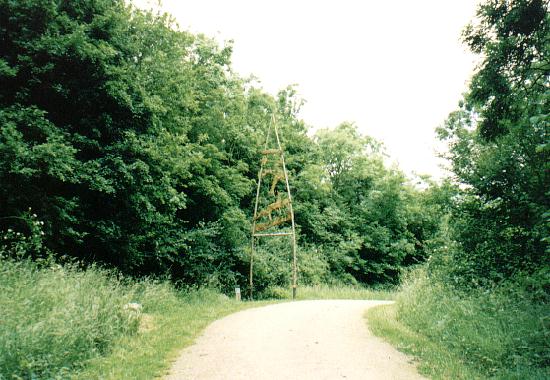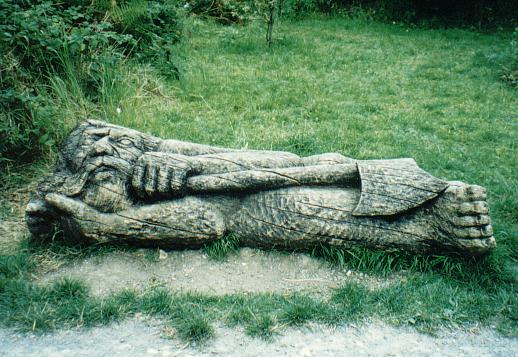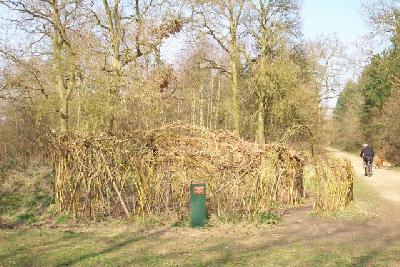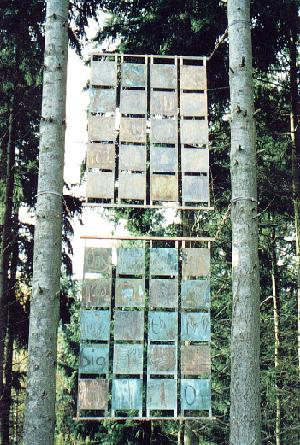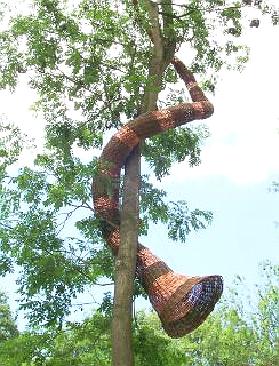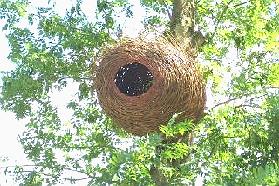|
The sculpture trail in Bourne Wood
In an attempt to popularise the woods, the Forestry Commission introduced a woodland sculpture project in conjunction with local authorities and community groups
to enable resident artists execute and display their work in a woodland setting.
This was the first of the sculptures to be erected, a lofty work sited on the brow of a hill beside a turn on the main
track, pictured above. The 30 foot high sculpture depicted woodland creatures springing between the curved sides of the arch and
was intended to create a two-dimensional pattern against the sky. But it
did not win the admiration of all visitors because it was vandalised on several occasions and parts
were replaced but in the summer of 2001, the damage became so extensive
that it was dismantled altogether.
This work is glimpsed invitingly through a gap in the trees near to the main entrances to the wood. The sculpture guide describes it thus: "A gently rising path, surfaced with bark and wood chippings sympathetic to the tread, draws you forward between overlapping curved slices of turf-covered banks of increasing height. An experience of literally entering into the landscape. As you pass through the earthwork, the banks diminish in height and glancing back they appear as flowing ripples which may at any minute inundate the path along which you have passed." We are told
that Harris is a sculptor of international standing and that "his manipulation of the landscape heightens our awareness of the slopes and folds of the surrounding woodland clearing and sharpens our perception of the twists and turns of the forest paths".
This sculpture is sited close by the car park in the centre of the wood. He lies in an open space at the junction of several paths, an axe beside him, open hand beneath his chin, like an ancient spirit of the woods inviting us to explore the more secluded walks. Todd has skilfully carved the figure so that it retains the qualities of the section of fallen ash trunk from which it is fashioned.
This is carved from another piece from the same trunk, exhibiting the same primitive, massive qualities and convincing distortions of scale. It depicts a boy asleep with crows resting in his open hand, providing an image of man in harmony with nature.
Her cluster of carvings can be found close to the main track through the centre of the wood. A path rises from a gravelled clearing and two circles of giant carved mushrooms are glimpsed through the trunks of the pines. The mushrooms in each ring are stained in different colours and rhythms are set up within the rings as the individual fungi writhe in characteristic forms. The relationship of the mushrooms within the rings and of the two circles to one another, by their very strangeness, enhance the experience of the spaces between the trees on the gently sloping hillside. Kerry Morrison carved mainly from oak using a chain saw. Paul was resident sculptor alongside Kerry Morrison, although working in stone rather then wood. His piece is carved from a large block of local Ancaster stone, donated by Gregory Quarries Ltd of Mansfield. The carving has subtly modified the block to reveal a couple sitting and relaxing amongst the bracken. Yet the figures do not intrude and the block retains the qualities of a natural outcrop of rock. The piece could be seen as a metaphor of our relationship with the woodland. We should come and enjoy but not dominate.
JOHN FORTNUM - Robert de Brunne This is the most controversial of all the sculptures and one that has provoked the most argument. It was even once set on fire by vandals. The statue is approached by a gravelled path from the main track, at the beginning of which a giant footprint gives our first intimation of the sculpture's presence. The path winds through dark pines, emerging at the rear of this gigantic piece. A vertical cone of pine logs soars 30 feet, broken only by the cast concrete head which gazes with remarkable presence across an open area with ponds, over the trees beyond towards Sempringham Abbey, the home of Robert's order of Gilbertine monks. This piece with internal ladder and viewing platform is believed to be the largest work completed by a British sculptor working alone. ¬ NOTE: Unfortunately, vandalism and the weather took its toll on the structure and over the years the wood began to rot making it unsafe for public viewing and so it was dismantled in 2003 and the concrete head returned to the sculptor. JOHN FORTNUM & pupils - Milestones
During John Fortnum's residency, he worked with students from the sixth form at Bourne Grammar School, to create a number of "milestone" sculptures in cast concrete, which are sited throughout the wood.
CLARE WILKS - Helter Shelter This is a living willow sculpture by Clare, an artist with a growing international reputation. It can be found at the junction of two forest tracks, the passageway of open woven willow fence spirals us in towards the small opening of a central, densely woven shelter. Since the whole sculpture is living and growing, the rhythms of its structure respond to the changes of the seasons, putting forth new growth in spring or shedding leaves in autumn. Clare also worked with students from Bourne Grammar School enabling them to create a willow sculpture in the woodland close by. This takes the form of a clover leaf with domed arbours approached by a tunnel.
Their school unfortunately closed in 1999 when the local authorities decided that the premises were unsuitable for their original purpose and pupils were transferred to a new centre in Abbey Road administered by the Stamford and Bourne Learning and Disability Service. WOODLAND TUNNEL - Students from Emerson College, East Sussex
Although the original Sculpture Trail is complete, new works are still being added to the wood and in the summer of 2002, a series of strange artworks intended to draw visitors into the very depths of the forest were erected. They consist of four pieces of curved timber of diminishing size and erected in line to create a tunnel effect. The sculptures are the work of students from the School of Sculpture at the Emerson College in East Sussex and were placed in position on Monday 8th July. They are situated near to the public car park and lead visitors directly to the main woodland trail.
The first and largest section is more than nine feet tall, the second slightly smaller, the third smaller still while the fourth, almost obscured by undergrowth, is only one third the height of the first. All are made with wood obtained from sixty-year-old oak trees which had been cut at Temple Wood, five miles north of Bourne. Forester John Wilcockson explained: "It is a very simple and incredibly effective design and the result is rather like looking down the wrong end of a telescope. The sense of perspective is quite wonderful with the viewer's eye being drawn straight into the heart of our woods." CLARE WILKS - Horn & Nest
By 2015, many of the sculptures had disappeared while those that remained were neglected and often hard to find and so a worthy and well-meaning project that did manage to create some public interest for a few years has foundered through disinterest. REVISED APRIL 2015 NOTE: All photographs by Rex Needle. Notes compiled with the help of the leaflet
Go to: Main Index Villages Index |
||||||||||||||
